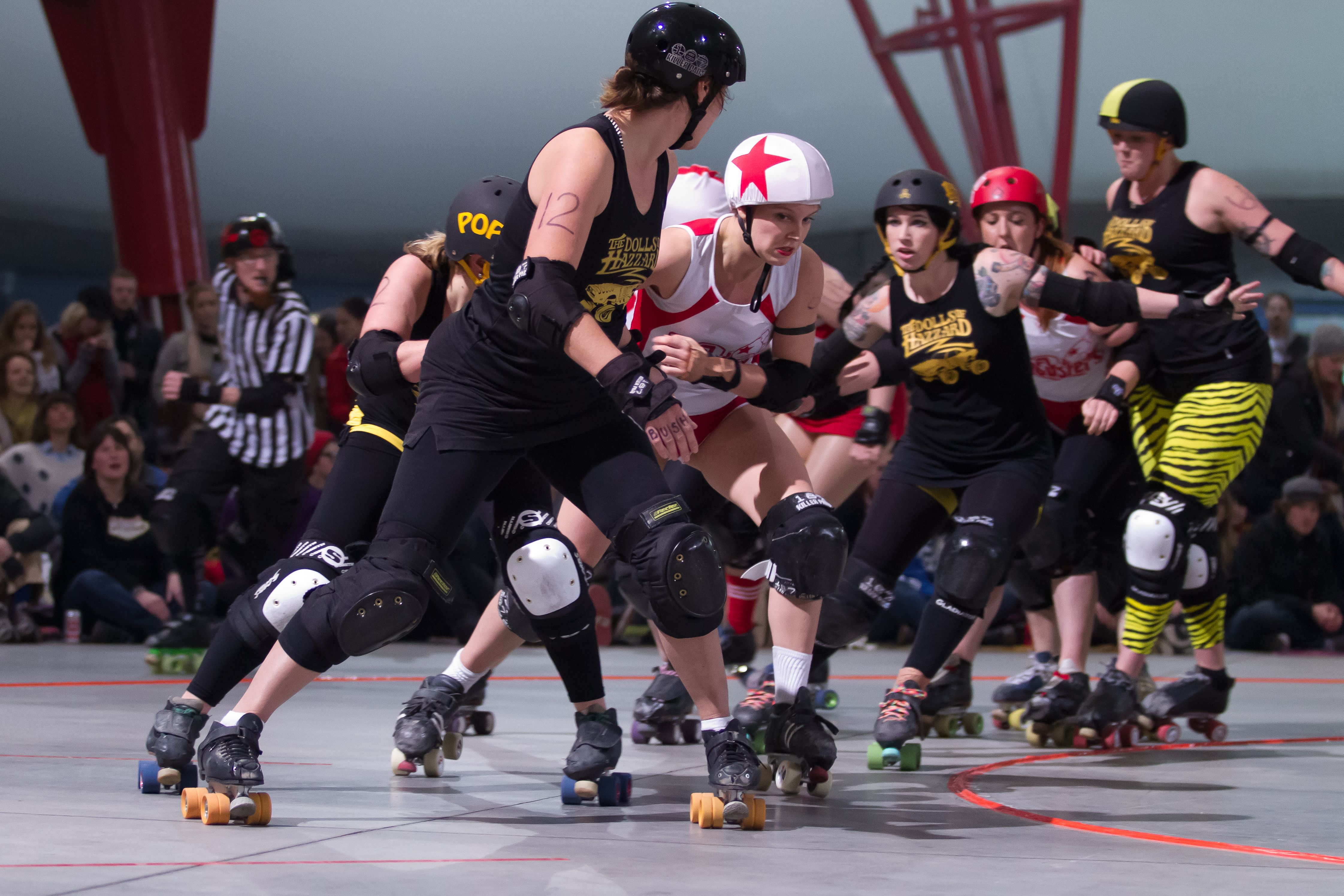The shrill ringing of whistles bounces off the pavilion walls, cutting through a blasting rock track, and the chatter of an eager crowd. Though it’s a lively noise, it isn’t one to be taken lightly – it’s the soundscape for the fastest growing women’s sport in the world. The Victorian Roller Derby League (VRDL) have been holding bouts since 2007, after a group of women in a Dandenong shed watched YouTube videos to teach themselves the basics. In quad skates and more padding than you’d find in a bed store, they fanned the flame of the grassroots revival of Flat Track Derby sparked by the Texas Rollergirls in Austin in the
early 2000s.
More than 100 members now make up the VRDL, with four home teams, two travel teams, a recreational group and regular bouts held at the Melbourne Showgrounds. Skater for the Dolls of Hazzard and the All Stars team, Skate Bush (45RPM), joined the League not long after it’s inception and says numbers are increasing all the time. “I think a lot of people join because they like the image of roller derby, because it seems a little bit rock and roll, a little bit underground, a little bit different,” she says. “Although of course it’s very far from theatrical. I think the name is the only thing that is these days”.
Fellow Dolls of Hazzard skater Alex in Chains (C4) says the importance of the Derby name has changed for her since she started with the title Boom Crash Oprah in 2010. “When I first started derby it was all about having a kick-ass name and doing something cool, I guess it gives you the confidence to go a little harder. But as time goes on, I’ve kind of dropped that whole second persona thing. It’s really just me. People call me Alex, that’s my real name. It’s not an alter ego anymore – it’s more of a sport and less of a hobby.”
Though the punny names remain intact, the Derby revival has seen a greater emphasis on strategy and athleticism than its 1940’s predecessor. In February this year, the International Olympic Committee announced it as one of eight sports under consideration to be part of the 2020 Olympic Games. It comes with the promise of more than a little rough and tumble. As one jammer for each team seeks to pass the opposing teams blockers, accumulating points and excited cheers as they do, inevitable causalities hit the track floor.
But, as far as contact sports go, derby stands out from others in its origins. “It’s the only women’s contact sport that you can play that hasn’t been based off a male contact sport,” says Alex in Chains. “Roller Derby was created by women, for women and it’s our sport. That’s what makes it awesome”. Listening to skaters’ stories, you can almost feel the adrenalin rush yourself. In September, Alex in Chains had a “glory moment” when skating in a bout against Brisbane’s Sun State Roller Girls. “I hit their opposing Jammer out at the very last second. I was the last Jammer of the game and I managed to hit their Jammer out and down. When it was over I threw my hands up in the air and everyone was cheering,” she says. “I suppose the uplifting crowd makes it all worthwhile.”
The DIY nature of the Derby revival is a significant part of its appeal, but with the sport’s increasing popularity and international recognition questions of sponsorship and professional opportunities come in to play. “It would be great to have more sponsors in there, but we have to tread very carefully because we wouldn’t want the game to be changed to be a spectacle, it’s more of a sport,” says Alex in Chains. Victoria University sports expert Doctor Caroline Symons says there are few team games like roller derby that are managed by women. “Netball is one of those examples, it’s not a contact sport but it’s certainly a very strong example. That’s probably the only other sport you’ll find that is still controlled mostly by women”. After recently attending her first bout with her 12-year-old in tow, Dr Symons chuckles acknowledging the difference in sponsors for the two sports. “What was it, the Samurai AV that organizes zombie events? I was thinking, the sponsors aren’t quite the same as the netball where you get Fisher & Paykel and Coles.”
Beyond the sport element itself, Skate Bush testifies to a strong sense of camaraderie between the VDRL athletes. “Everyone gets along really well. I think there are so many huge personalities and so many different types of people there, but there’s a great deal of respect for each other in our league.” Peering around the audience at a bout, it’s clear roller derby draws fans from a wide range of ages and subcultures. Young children hold up lovingly crafted signs with the smallest hands, while many spectators line the track edge on blankets or get the prime viewing spot standing on the back platform.
There’s also a feeling of diversity among the VRDL players themselves. Any woman who is 18 or older is allowed to join, though the majority are aged between 25 and 35. All body types are welcome. “It’s the only sport that I can think of other than Sumo wrestling where size is an asset, and it doesn’t matter what your body type is. There’s always a role for you, whether you’re slim and tiny or a big girl or muscly. Every body shape has a role out there on the track”. With about 30,000 skaters worldwide and 21 Australian leagues spread out over seven states, it seems as if roller derby’s second incarnation has gone from strength to strength, and the way skaters speak glowingly of the sport suggests its value goes far beyond the sport itself.
Marnie Banger
Photograph by Manning Blanchard


